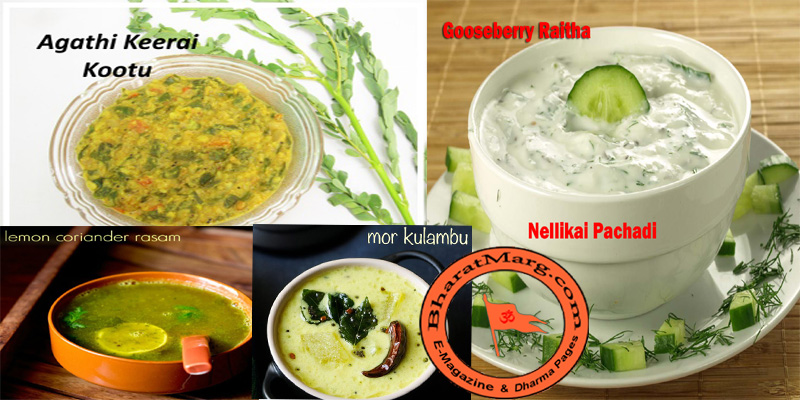The Day next to Ekadhasi is Dwadhasi. In Dwadhasi Cooking after fasting for Ekadasi, its recommended not to use Tamarind. So you can follow the given recipe for a delicious food with no Tamarind. You Buy 3 portions of Ahathi Keerai (Special spinach) and offer One for your home, One for Cow and one for Dhaan to anyone.
You should eat a bit early and skip the large food after that is the recommendation. Check out the Perfect Dwadasi Menu & Receipes the day after Ekadashi fasting!!
Steps To Make The Agathi Keerai Kootu:
Preparations, first pressure cook the Moong Dal (Paasi Paruppu) with 3\4 cup of water and 1\4 tsp of turmeric powder in a bowl for an 1 whistle and 3 to 5mins over simmer. Keep aside.
To make masala powder, dry roast the Bengal Channa Dhal (Kadalai Paruppu) in a hot kadhai till golden color and keep aside. Then dry roast the pepper and cumin seeds. Cool all the roasted ingredients, grind into fine powder and keep aside.
Grind the coconut and fennel seeds into paste with required water and keep aside.
To make the kootu (Baaji), heat the oil in a pressure cooker pan, temper the mustard seeds and urad dal (Ulutham Paruppu). Fry and add the seasoning till slightly as it becomes golden in color. Add the tomato and cook for two minutes. Add the agathi keerai and cook till they shrinks. Add the red chili powder, coriander seeds powder and turmeric powder, mix well for half a minute. Add the coconut paste mixture and mix well.
Add a cup of water, pressure cooked Moong Dal (Paasi Paruppu) and required salt, mix well and bring to boil. Cover and pressure cook for an whistle. When all the steam is released, open the pan, add the Bengal Channa Dhal (Kadalai Paruppu) powder mixture, mix well and ready to serve.
Lemon Rasam Recipe
- Rinse and then add 1/4 cup Toor Dal in a pressure cooker along with a pinch of turmeric powder.
- Add 3/4 to 1 cup water and pressure cook for 8 to 9 whistles or till the dal has softened and cooked really well.
- When the pressure settles down on its own, check the dal and mash it with a spoon or wired whisk. Keep the dal aside.
Making Lemon Rasam
- In a small grinder or chutney grinder, take 1/3 cup chopped coriander, 2 tsp cumin seeds, 1/2 tsp black pepper, 1 or 2 green chilies (chopped), 1/2 inch ginger (roughly chopped) and 4 to 5 garlic cloves (roughly chopped).
- Without adding water grind to a coarse paste. Keep aside.
- In a pan or pot, heat 1 tbsp sesame oil or any oil and add 1/2 tsp mustard seeds. Saute till the mustard seeds start crackling.
- Then add 12 to 15 curry leaves and 1 to 2 dry red chilies. Saute till the red chilies change their color and darken a bit. Don’t burn them.
- Now add the ground coarse paste along with a pinch of asafoetida/hing and 1/4 tsp turmeric powder. Stir very well.
- Add the cooked dal and add 1 to 1.5 cups water. Stir well.
- Season with salt and again stir.
- On a low to medium flame simmer the rasam for 5 to 6 minutes.
- Switch off the flame. Wait for 1 minute and then add 2.5 to 3 tbsp lemon juice.
- You can add more or less as required and as per your taste. Instead of lemon you can also add lime juice. stir very well.
- Garnish with some coriander leaves & serve lemon rasam with steamed rice.
Nellikai Pachadi Recipe (Amla/ Gooseberry Raita)
- To begin making the Nellikai Pachadi Recipe, into a blender grind the raw gooseberries, grated coconut, green chilli and salt into a coarse mixture. Keep aside.
- In a bowl whisk the yogurt well until smooth. Stir in the ground gooseberry mixture and grated cucumber. Check the salt and spice levels and adjust to suit your taste.
- Transfer the Nellikai (Amla) Raita into a serving bowl.
- The next step is to make the seasoning for the Nellikai Pachadi. Heat oil in a small pan; add the mustard seeds and curry leaves. Allow them to crackle.
- Pour the seasoning over the Nellikai Pachadi (Amla Raita) and stir it in and serve with your choice of Pulao recipe to a wonderful meal.
Mor kulambu / Majiga Polusu / Kadi ( Without Basin Powder )
When making mor kulambu, you can add some vegetables or skip them entirely. I often add either ash gourd (White or Yellow pumpkin, winter melon, petha, poosanikai) or okra (lady finger, bhindi, vendakkai) when making mor kulambu.
Making paste
- Take 1 tablespoon Toor Dal, 1 teaspoon coriander seeds, ½ teaspoon cumin seeds and ½ teaspoon raw rice.
- Using a fine tea strainer rinse them. You can use any type of white rice. If you do not have rice, then 1 to 2 teaspoons of rice flour can be added instead while grinding.
- Then take all of them in a bowl. Add ¼ cup hot water. Soak for 20 minutes.
- Then take the soaked tuvar dal, coriander seeds etc along with the soaked water in a small grinder jar or chutney grinder.
- Add 3 to 4 green chilies (chopped), ½ inch ginger (chopped), 5 to 6 curry leaves and ¼ cup grated coconut.
- Grind to a smooth paste. Keep aside.
Making curd mixture
- Take 1 cup thick curd which is slightly sour in a bowl or pan. Beat it till smooth.
- Add the ground coconut paste. Then add 1 cup water. Mix very well. Keep aside.
Cooking White / Yellow Pamkin or Okra
- Meanwhile when the rice and lentils are soaking, you can cook the pumpkin. Rinse, peel and chop ash gourd. Take the chopped ash gourd in a pan.
- Add ¼ teaspoon turmeric powder and 1 cup water. Stir.
- Cover the pan and keep it on a medium-low flame. In between do check and give a stir.
- Simmer till the pumpkin is almost cooked.
Making Mor kulambu / Majiga Polusu / Kadi ( Without Basin Powder )
- Reduce the flame to a low or you can switch off the flame. Then add the curd+coconut mixture. mix well.
- Season with salt as per taste. Mix again.
- Simmer the kuzhambu on a low flame. Do stir occasionally.
- The entire kuzhambu has to come to a boil. Once you see the kuzhambu boiling, then switch off the flame. Cover and keep aside.
Making tempering for mor kuzhambu
- Heat 1 to 1.5 tablespoons oil in a tadka pan or small pan. You can use gingelly oil (oil made from raw sesame seeds) or sunflower oil or safflower oil or even ghee.
- Add ½ teaspoon mustard seeds.
- Let the mustard seeds crackle. When the mustard seeds crackle, add ¼ teaspoon fenugreek seeds.
- Quickly add 1 to 2 dry red chilies, 7 to 8 curry leaves and 1 generous pinch of asafoetida (hing). Stir and switch off flame.
- Pour this tempering mixture in the mor kulambu. Cover for five minutes and let the flavors infuse.
- Serve more kulambu with steamed rice.





